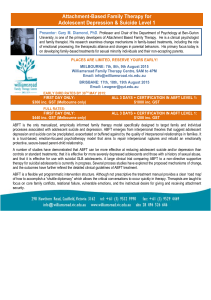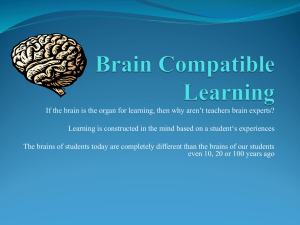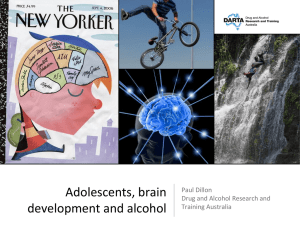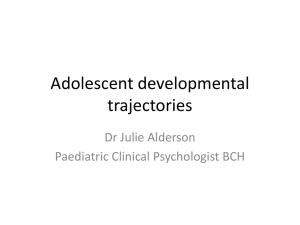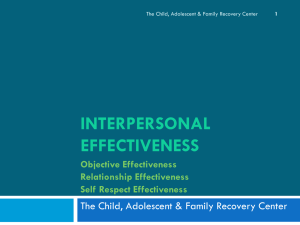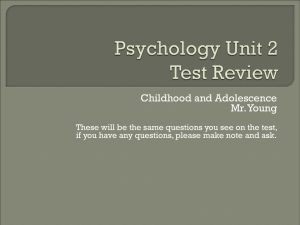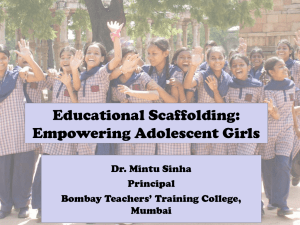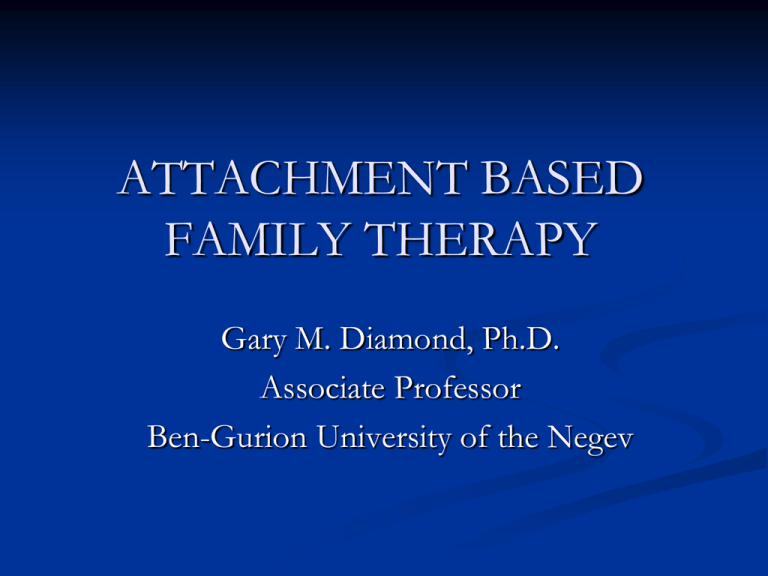
ATTACHMENT BASED
FAMILY THERAPY
Gary M. Diamond, Ph.D.
Associate Professor
Ben-Gurion University of the Negev
Overview
Brief, focused treatment (12 to 16 sessions) designed
specifically for treating depressed and/or suicidal
adolescents
Empirically informed and supported
Manual is principally/task driven, focused, detailed but
flexible
Built around 5 distinct, yet interrelated treatment
“tasks”
Based in attachment theory and Structural Family
Therapy
Overview
Center for Family Intervention Research,
Children’s Hospital of Philadelphia, University
of Pennsylvania School of Medicine
Guy S. Diamond, Ph.D
Gary M. Diamond, Ph.D.
Suzanne Levy, Ph.D.
Lynne Siqueland, Ph.D.
Theoretical and
empirical basis of the
treatment
Normative Adolescent Development
and Developmental Psychopathology
Past models of normative adolescent development (Storm and Stress)
(Blos, et al.)
Current, empirically-based description of normative adolescent-parent
relations (Steinberg, L.)
Shared values, respect and admire parents
Parental admiration, validation, care and protection still important
Increased sharing with and investment in peer group but connection
maintained around important issues (life decisions, crises, etc.)
Increased bickering about daily tasks (curfew, clothing, friends), but
does not threaten cohesion and bond
Less than 25% of teens report ongoing conflict, 80% of whom report
it started in childhood (In other words, high conflict is not the
norm)
Not only is high adolescent-parent conflict,
parental rejection, criticism and neglect not
normal, but such processes place adolescents at
a higher risk for both depression and
suicidal ideation.
How?
Mechanisms linking negative adolescentparent processes and adolescent
depression/suicide
Negative parental behaviors, such as criticism, rejection and
abuse are both directly and directly linked to adolescent
depression and suicide.
They are DIRECTLY linked because parental criticism, abuse
and neglect makes kids feel bad about themselves.
When parents tell or make their children feel like something is
wrong with them , that they are a burden, adolescent’s internalize
these messages.
They begin to feel worthless, like failures, helpless, hopeless and
alone. Self-esteem decreases, self-efficacy decreases.
Such perceptions of themselves and experiences are directly
correlated (empirically) with depression and suicidality.
Mechanisms linking negative adolescentparent processes and adolescent
depression/suicide
They are also INDIRECTLY linked to depression and suicide
via the quality of the attachment relationship.
More specifically, when parents are critical, abusive, rejecting, or
neglectful, the attachment relationship is ruptured.
What does that mean?
Secure attachment is defined as the adolescent’s experience of
her/his parents as being: caring, responsive to signals of
distress, and willing and able to comfort/protect their
adolescent when necessary.
Secure attachment during adolescence is important because it is
what allows the adolescent to turn to her/his parents when
she/he is being teased at school, feels like a failure in school,
is terribly upset after the break-up with romantic partner,
etc. and receive support, guidance and protection.
When the attachment is ruptured (i.e., insecure attachment),
parents are no longer available as a resource to soothe and
modulate the pain and loneliness leaving adolescents more
vulnerable.
Moreover, when adolescents do not turn to their parents in times
of needs, it can impair the development of important
social/cognitive/emotional skills that are important for
functioning in general and interpersonal relationships in
particular (emotion regulation, perspective taking, problem
solving) – skills which buffer against negative mood,
hopelessness, depression and suicide.
In contrast, when adolescents do turn to their parents to talk
about a problem, such discussions provide a context for
adolescents to learn and practicing: articulating their feelings,
differentiating between emotions, identifying underlying
needs/wishes, reflecting on the situation, gaining
perspective, and problem solving.
Optimally, the parent serves as a partner and guide in this
process (they signal that all feelings and thoughts are legitimate
[i.e., psychological autonomy]; ask Socratic open ended
questions; resonate and empathize).
In this context, each crises is a learning
opportunity for the adolescent – an opportunity
to talk, explore, feel, figure things out and
develop adaptive responses.
Indeed, much research has found that
attachment quality (perceived care and
protection) in adolescence is correlated with
depression and suicidality.
Finally, the attachment relationship is important
because parents are there much of the time.
They see their child when s/he comes home
from school, get’s off the phone with their
boyfriend or girlfriend, at meal times and before
they go to sleep. When there is contact and
disclosure, the parents can be the first to know
when the adolescent’s affective state is changing,
when they are in trouble, etc.
Attachment in Adolescence
For
all of the reasons above,
attending to and shaping parentadolescent interactions and
improving the adolescent-parent
attachment relationship is the
primary focus of ABFT.
Reasons for ruptures
In order to work on improving attachment, it
helps to have a map of some of
events/processes that have impaired or
ruptured the adolescent-parent attachment
relationship.
TRAUMATIC EVENTS: psychological or
physical abuse, sexual trauma, abandonment or
neglect, etc.
CHRONIC NEGATIVE INTERACTIONAL
PROCESSES: high levels of parental psychological
or behavioral control, low parental affection (e.g.,
neglect), parental criticism, parental neglect and
conflict.
Interactional patterns preventing
the rupture
Avoiding engaging their adolescent in conversation
about what is bothering them, perhaps because they
feel guilty, incompetent, overwhelmed, pained.
Criticize their child for not “trying harder” and solving
their problems themselves.
Personalize their child’s distress and become
defensive.
In short, disappear, lecture, minimize, criticize and
blame.
Theory of Change
The essential change mechanism is through creating
corrective attachment and corrective emotional
experiences.
1) Parent (with our preparation and help) adopts an
interested, empathic, regulated, non-defensive posture
regarding the adolescent’s experiences of what has
ruptured the attachment relationship.
2) Whatever the content (trauma, chronic negative
processes, or feeling like the parents’ responses are not
helpful), our aim is to create a conversation in which
the adolescent experiences, perhaps for the first time,
her/his parent as curious, interested and able to hear
and contain their experience (anger, disappointment,
sadness, fear, etc.) without reprisal, criticism,
defensiveness.
3) Adolescent feels cared for and safe, and therefore
opens up even more, describing her/his experience in a
more elaborate and differentiated manner.
4) Parent validates adolescent’s experience,
acknowledges that they were not aware of their child’s
full feelings and and/or their part in that process.
Sometimes it includes an apology. Usually includes an
explicit commitment to being there for their child
more.
5) Child feels validated and secure.
6) Parent may add information that adolescent didn’t
know previously.
Leads to new representations or internal working
models (or at least experience) of their parents.
Parents are perceived as safer, more available, and able
to understand and protect – better attachment
figures.
Leads to more approach behaviors by adolescents and
satisfaction for adolescent – positive relational cycle.
Unique advantages of Conjoint
Family Therapy
Having the parent (actual object) in the room
and discussing the emotional injury with that
person is particularly emotionally arousing
and meaningful.
Research on exposure and experiential based
therapies (Foa; Greenberg)
Seeing the other make an effort, express care,
listen and try to act differently increases hope
New interactional cycles are shaped and
practiced with both sides of the interaction - in
and outside of sessions.
Expected Adolescent Outcomes
Increase capacity to put feelings into words
Increase tolerance and ability to manage high
emotional arousal (rather than acting them out)
Increased ability to express explicitly
attachment/relational needs (rather than acting
them out)
Enhance capacity for insight, perspective taking
(mentalization) and problem solving.
Increased motivation to turn to parents and
other’s in times of distress
The ABFT Model
We stand on the
shoulders of giants
Structural family therapy
Salvador Minuchin
Multidimensional FT
Howard Liddle
Emotionally focused therapy
Leslie Greenberg and
Susan Johnson
Contextual family therapy
Ivan Boszormenyi-Nagy
Attachment theory
John Bowlby
What is ABFT?
Series of 5 in-session tasks that prepare for and
facilitate corrective attachment experiences.
Five Treatment Tasks
Relational
Reframe
Alliance
with the Adolescent
Alliance
with the Parent
Reattachment
Promoting
Task
Competency Task
ABFT Treatment manual
Not a set of rules but a set of principles
Goal Driven
Flexible in how one reaches the goal
Intentionality, intentionality, intentionality
Not a curriculum but a road map
Task #1: Relational Reframe
Bond: Building Alliance with family as whole
A. Initial focus on strengths, support systems and
resources.
B. Discussion of depression-suicidal ideation. What
are the adolescent’s and parents’ constructions
regarding what is the causing the distress.
Sometimes it is family factors (father doesn’t call)
Sometimes it involves things going on outside the
family (he gets teased mercilessly at school).
Need some details but not a lot at this point and
do not get at all into problem solving.
Relational Reframe
Next, we implement the essential intervention of this task:
C. The Relational Reframe.
Involves changing the focus of the treatment from
“what is causing the depression” to “why don’t you go
to your mother when you feel so bad about yourself
that you want to die?”
Problem/Solution
“Why don’t you go to your mother when you feel so
bad that you want to cut your wrist?”
Relational Reframe
Typical questions/interventions that we use to reframe
the focus of therapy in relational terms include:
“Do you go to your parents to tell them when you feel
so bad”
“Why not?”
“Mom, do you have any ideas why she doesn’t come to
you?” Sometimes parents have some theories that are
usually accurate, sometimes not at all (open door
policy”
Relational Reframe – motivation
and sign-on
“Do you wish it was different?”
“Mom, do you wish she would come to you?”
Don’t get too into the details – not the time to solve
the problem.
Want to amplify the loss, sadness and motivation.
Get the sign-on:
“This is exactly what I want to focus on in this
treatment – what makes it hard for her to come to you”
We can help this be easier.
Establish relationship building as the goal
Task #2: Alliance Building
with the Adolescent Alone
Three Phases of Adolescent Alone
Session
1. Bond
Identify Strengths
Engage adolescent in order to increase comfort, reduce tension,
suspicion
Establish self as an ally - validate adolescent’s complaints and
particularly attachment needs.
“This therapy is not about telling you what to do - I am interested
in helping you to be heard”
2. Individual goals – Go back and identify the problems that
concern and are important to the adolescent.
“I wish kids would stop teasing me”
“I wish my dad would stop putting me down”
Get adolescent on record as “being miserable”.
Three Phases of Adolescent
Alone Session
3. Relational goal (relational reframe)
“Why don’t you go to your parents when you feeling
so bad, when you are trying to figure this out?”
YES: What happened? (Lecturing, criticism, minimizing)
NO: Why not?
How do you think they’d respond?
If I could get them to listen, would you be willing to tell
them so that you could work them through or get
support? Get sign-on to trying.
Working with Resistance
If the adolescent is concerned about burdening their parent:
Why don’t you deserve to have these things addressed?
These things are killing you, they are driving you to selfdestruction, you deserve to be heard.
What you are doing is causing your parents more pain.
Your parent will grieve for the rest of his/her life if you
take yours.
We will support your parents
If the adolescent is concerned his/her parent won’t listen:
You’ve never tried it with me. I can make it different. I
can make her listen. I will protect you.
Preparation for the reattachment
session
Once the adolescent agrees, he/she must be prepared:
Therapist helps adolescent prepare what they want to say.
Therapist helps the adolescent explore their potential
emotional reaction.
Help the adolescent process their old behaviors/potential
emotional reaction to help them evaluate their behaviors
(i.e., were they effective? Is it a good strategy) in order to
gain insight.
Discussion about effective ways to communicate in session.
Discussion of feared reactions.
Problem solving and preparing for patients ineffective
communication behaviors and feared reactions.
Setting expectations
Not easy. Parents may not preform perfectly,
this is not what they are used to.
Patience and forgiveness – successive
approximation.
Task #3:
Alliance Building with the Parent
Three phases of parent session
1. Bonding
• Systematic exploration of strengths and resources
• Current Stressors (divorce, drug abuse, money)
• Transitional statements – “How do you think this affected your
daughter and your relationship with her?”
• Intergenerational Exploration – parents’ own experiences of
attachment in their own childhood.
• Do you think your daughter feels like she can come to you for
help? Would you like to be there for your daughter in a way
that your mom was/ was not there for you?
2. Goals
• Parental commitment to be there for their adolescent in a
different way
3. Task
• Preparation for reattachment conversation
• Teaching parents Emotion Coaching
Task 4: Reattachment
Reattachment Task
Essentially and in-session enactment.
Task: facilitate productive discussion about core attachment
ruptures – not all content is equal
Process: adolescent uses new affect regulation and
interpersonal problem solving skills; parents use more
emotional coaching.
Affect is important – guide family members to access
primary, vulnerable emotions (fear, longing, desire to feel
loved)
Reattachment Task
Not teaching, not problem solving
The conversation is between the family members.
Therapists are as minimally involved as possible.
If therapist must help facilitate the conversation, gets
in and gets out.
But you are sculpting the conversation: the content,
the affect and the process
General Structure of the Session
Adolescent begins to disclose core content
Anger may be appropriate, but also try to elicit
softer, more vulnerable emotions
Parent posture is one of curiosity, validation,
questions.
When the time is right, the parents may
describe their experience, not as defensiveness
or criticism, but in an effort to offer the
adolescent new perspective on parents.
Sometimes parents offer an apology and the adolescent
offers forgiveness. But it can not be forced. It must
remain authentic
Therapist helps adolescent see his or her parents as
people; non idealized, but as vulnerable as them.
Don’t try to wrap it all up nice at the end. Only movies
end that way.
If there is some resolution, explore what they want
from each other going forward.
Task #5: Competency
Promoting
Promoting Competency
Re-engage adolescents in social world/activities
Identify appropriate challenges and goals
Parent’s are now viewed as a secure base and should
be used to support the adolescent in building
competency and set reasonable expectations
ABFT for
Depression and Suicide
ABFT has shown to be efficacious or effective
with depressed and suicidal adolescents in 5
clinical studies.
Larger portion of our research populations have
a history of trauma: physical, emotional and
sexual abuse.
Open trial (1995)
First clinical trial
Conducted at the Philadelphia Child Guidance
Clinic – outpatient center
Showed marked and significant decreases in
both depression and suicidal ideation in 15
adolescents.
Randomized Clinical Trial (19961997)
NIMH R34 treatment development grant
32 patients, ABFT or wait list control
Significant reductions in percentage of
participants diagnosed with diagnosis, level of
depressive symptoms, suicidal ideation, and
anxiety. Increase in family attachment.
(Diamond, G.S. et al, Journal of the American
Academy of Child and Adolescent Psychiatry, 2002).
Randomized Clinical Trial (2004-2007)
CDC funded
66 adolescents randomized to ABFT or Enhanced
Usual Care (EUC)
70% female, 80% African American
50% had previous attempts, 30% MDD, 80%
Anxiety
50% reported a history of sexual abuse
(Diamond, G.S., Journal of the American Academy
of Child and Adolescent Psychiatry, 2010).
Suicide Ideation (SIQ)
BDI Response, 50% Reduction from
Baseline
Suicide and
Sexual Abuse History
Adolescents with a history of sexual abuse are
more likely to have: suicide ideation, suicide
attempts, and multiple attempts.
Depressed adolescents with a history of sexual
abuse did not respond well to Depression
focused CBT or CBT plus medication (TADS,
TORDIA, etc)
Suicide Ideation – Sex Abuse
Depression – Sex Abuse
ABFT for GLBT Adolescents
Open trial, 10 GLB adolescents with severe suicidal
ideation
Phase I – manual development
more time with parents
heighten parents' awareness of micro aggressions
help families reduce or resolve parental non-acceptance.
Phase II – treatment
Average of 12 sessions completed
Significant decrease in depressive symptoms and suicidal
ideation from baseline to week 6
Decrease in attachment related anxiety from week 6 to end of
treatment
Diamond GM, et al (2012), Psychotherapy.
Today
NIMH - 5 year study
ABFT vs. Family Enhanced Individual Therapy
in community mental health clinics
130 patients randomized
Israel
ABFT for young adults with unresolved anger
toward parents
ABFT and EFT reduced psychological symptoms
and attachment anxiety and increased forgiveness.
Only ABFT reduced attachment avoidance (i.e.,
increase in clients going to parent for support).
Israel
Current study using ABFT to help mend
relationships among LGB young adults and their
non-accepting parents
Trainings
Trainings in Belgium, Sweden, Norway,
Denmark, Italy, Spain, Poland, Australia, US and
Israel
בית הספר החדש לפסיכותרפיה
http://thenewschool.co.il/
gdiamond@bgu.ac.il


